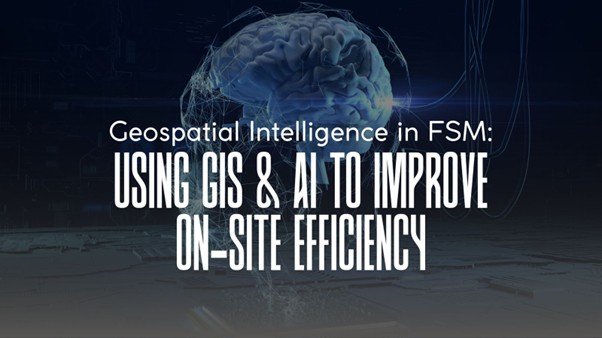Geospatial Intelligence in FSM: Using GIS & AI to Improve On‑Site Efficiency

Quick Summary
Geospatial intelligence FSM fuses GIS in field service with AI to deliver transformative efficiency for mobile teams. Real‑time location mapping, predictive analytics, and route optimization cut travel time, lower costs, and boost on‑site success. FieldEZ’s FSM platform leverages this to ensure faster dispatch, better asset utilization, and superior customer experience.
Enhancing field service through actionable geospatial intelligence and AI powered GIS analytics.
In the highly competitive current field service environment, any company can no longer afford to utilise static planning or manual scheduling. Finding smarter methods to make smarter, location-based decisions is needed to capture the complexity of servicing scattered assets, immediate requirements, and fluctuations in traffic needs. It is then that the geospatial intelligence FSM comes in handy.
Integrating GIS in field service elevates FSM platforms into dynamic command centers. This is where live maps, AI routing, and spatial analytics converge to drive faster, smarter, and more cost‑effective field operations. In this blog, we’ll explore how FieldEZ leverages geospatial intelligence and GIS technologies to improve on‑site efficiency.
Snapshot:
- GIS mapping in FSM enables real‑time technician visibility
- AI‑powered route optimization cuts travel time by as much as 30–40% (Esri case study)
- Predictive maintenance informed by spatial patterns
- Geofencing supports proactive SLA compliance
- FieldEZ clients see double‑digit fuel cost reductions and faster MTTR
What Is Geospatial Intelligence FSM?
Geospatial intelligence FSM refers to blending GIS (geographic information systems) with AI and real‑time operational data to enhance decision-making in field service management.
Key technical building blocks:
- GIS Mapping – Offers real-time visualization of technician locations, customer job sites, and asset infrastructure. It enables precise field team coordination and service transparency.
- AI Routing – Applies more intelligent algorithms to calculate the most optimal route of travel by considering traffic, technician skill level, and priority based on the SLA to ensure the maximum number of job assignments are possible.
- Geofencing & Alerts – Ensures that staff are at the correct location by putting virtual fences around work areas or client locations. With the entry and exit of technicians into and out of these areas, automated alerts are generated, which help in monitoring compliance and delays.
- Spatial Analytics – Analyzes past and real-time location information to identify patterns that include service demand hotspots, unserved areas, and SLA risk areas – and makes better resource allocation decisions.
- Remote Sensing Integration – Utilizes satellite data, sensors, or drones to monitor asset and environmental conditions, enabling a more proactive service plan and safer technician send-out.
GIS plots technician, job, and asset data on live maps while AI layers dynamic intelligence—this is the core of cutting‑edge FSM.
How can GIS in Field Service Enhance On Site Efficiency?
1. Real-Time Dispatch & Scheduling
GIS‑powered FSM platforms give dispatchers live visibility into field teams. Spatial dashboards help identify the nearest qualified technician, enabling automatic reassignment when priorities shift. According to industry studies, GIS systems significantly streamline dispatch planning and situational awareness. (Source)
2. AI Driven Routing & Traffic Integration
By pulling real‑time traffic data and leveraging spatial analysis, practitioners can trim idle travel. One Esri case study noted up to 30–40% improvement in dispatch efficiency using GIS‑integrated systems. AI‑driven workflows route technicians around congestion and minimize unproductive mileage. (Source)
3. Geospatial Asset & Demand Analytics
GIS heat maps reveal demand hotspots, enabling planners to schedule ahead where service needs cluster. Remote sensing or sensor integration adds another layer, signaling potential failures in geographically sensitive zones before they escalate. (Source)
AI + GIS: Predictive and Prescriptive Capabilities
Predictive Maintenance by Location
The assets in distinct areas may exhibit unique stressors: climate, terrain, and usage. GIS analytics flag patterns that suggest rising risk, enabling proactive scheduling of preventive visits and reducing unexpected breakdowns.
Prescriptive Dispatch Recommendations
Field Service Management platforms use AI to analyze past job outcomes, traffic patterns, technician skills, and spatial clusters. The system then prescribes technician-job-bindings, reroutes resources dynamically, or suggests alternate allocations to optimize SLA compliance and productivity.
Use Case | GIS + AI Integration | Business Outcome |
Asset Health Prediction | Sensor data + location history | Fewer unplanned repairs |
Technician Assignment | Skills + proximity + job urgency | Higher first‑time fix rate |
Routing Optimization | Historical GPS + real‑time traffic | Reduced travel time and fuel usage |
Operational Use Cases
Telecom Infrastructure Maintenance
Post-storm service restoration is expedited by mapping tower locations, fiber paths, and outage zones. FieldEZ’s GIS‑embedded dispatch ensures the nearest certified technician is assigned quickly.
Utilities & Smart Grid Operations
Utility companies overlay GIS data with real-time sensor feeds to detect anomalies. AI‑guided dispatch locates available crews pre‑positioned via spatial risk zones, reducing mean time to restore service.
HVAC & Home Services Scheduling
GIS‑based route planning considers traffic and zoning to plan daily service runs. Homeowners receive location-triggered ETA notifications; the system also geofences service areas to track technician movement.
Benefits of GIS Enabled FSM for Enterprises
Geospatial intelligence offers numerous benefits to organizations in field services seeking to modernize their operations and gain a competitive edge. Integrating GIS into field service operations enables businesses to utilize real-time location information, leading to a quantifiable change in strategy and execution.
Strategic Advantages
On a strategic level, GIS-based FSM platforms enable service leaders to make smarter choices, directly impacting profitability and customer satisfaction.
- First‑Time Fix Rate (FTFR) through better technician-job matching
- SLA Compliance by avoiding delays and routing intelligently
- Customer Satisfaction via transparency and faster service
- Fuel & Operational Costs due to optimized routes and reduced idle time
These advantages turn into healthier KPIs and better service margins, particularly in enterprises that have to handle significant mobile workforces or those that operate across jurisdictions.
Tactical Value
On the ground, GIS enhances technician effectiveness and back-office coordination—leading to fewer disruptions and more reliable service delivery.
- Real‑time mobile workforce visibility
- Fewer reschedules or conflicts
- Lower cost per service call
- Improved emergency readiness and response time
Research confirms that integrating GIS into FSM notably cuts labor hours, improves response times, and heightens operational efficiency.
For example, a report by Esri noted that utilities using GIS for field data operations reported measurable gains in resource coordination and service uptime. Additional studies from IBM and Fulcrum echo these findings, showing cost and time savings across industries such as telecom, energy, and logistics.
FieldEZ: Delivering Geospatial Intelligence to FSM
- Smart FSM Platform with GIS at the Core: FieldEZ embeds GIS mapping directly into the FSM interface—for desktop and mobile. Dispatchers view live layers: technician location, job backlog, traffic overlays, and customer zones.
- Custom Geofencing, Alerts & SLA Tracking: Clients set geofences around priority areas—triggering alerts when technicians enter or exceed time windows. The system flags impending SLA breaches in real time.
- Actionable Analytics & Intelligent Dashboards: FieldEZ’s dashboards aggregate geospatial insights, including job clustering, underserved zones, and technician efficiency heatmaps. AI models propose smarter scheduling and resource deployment.
Client testimonials include logistic operations cutting fuel spend by over 20% within weeks of FieldEZ’s GIS integration. (Exact case data available confidentially.)
Conclusion!
Field service organizations are changing how they plan, route, and respond using Geospatial intelligence FSM. Layering AI analytics on top of GIS in field service workflows enables service businesses. FieldEZ provides amongst the best layering AI analytics to achieve real-time discovery, more intelligent dispatching, and cost reductions in service delivery, improving operations by decreasing delays and inefficiencies. Are you ready to modernize your field operations with GIS‑enabled FSM?
Contact FieldEZ today to explore our AI‑powered geospatial solutions and begin turning spatial data into absolute service excellence.



